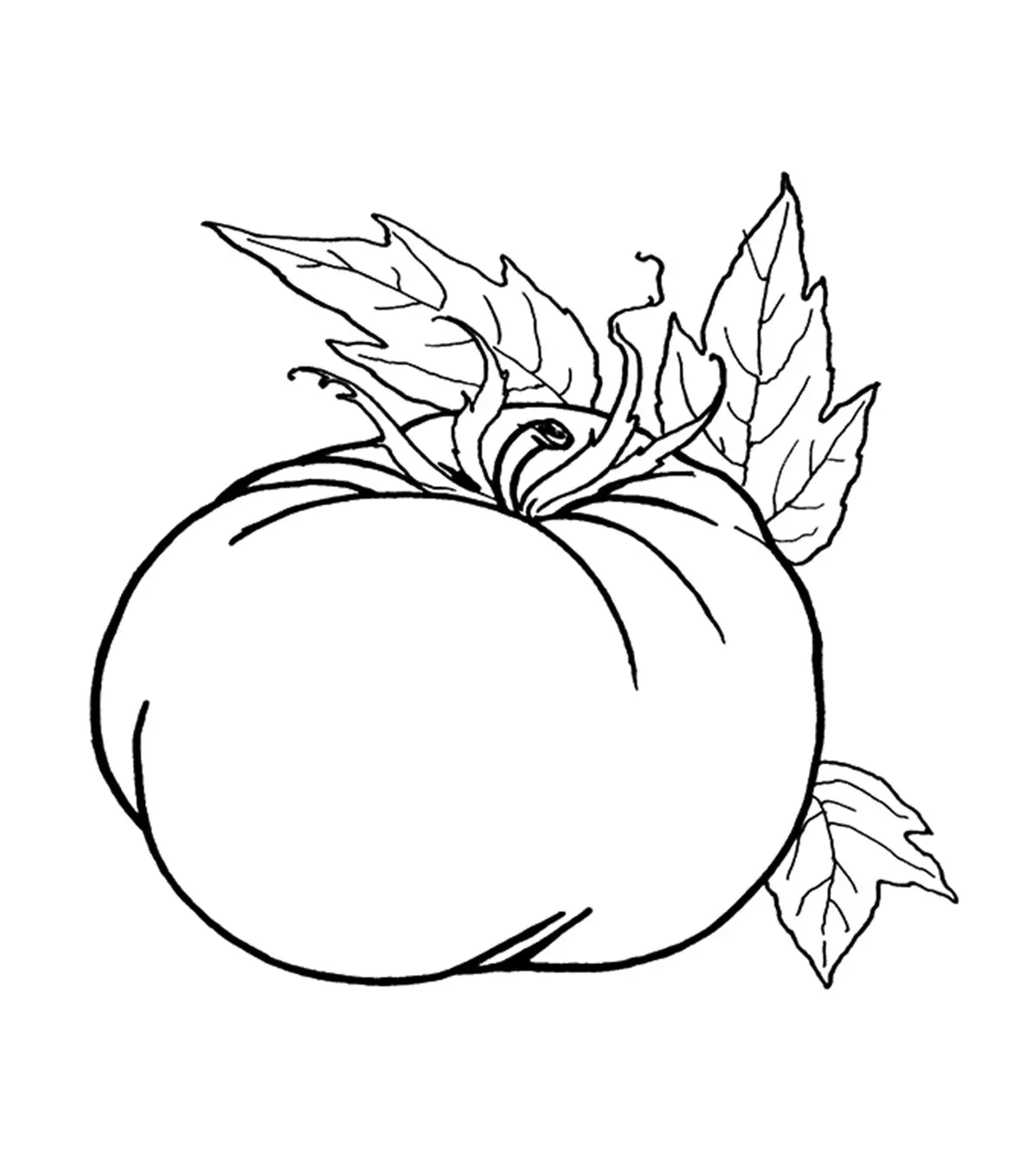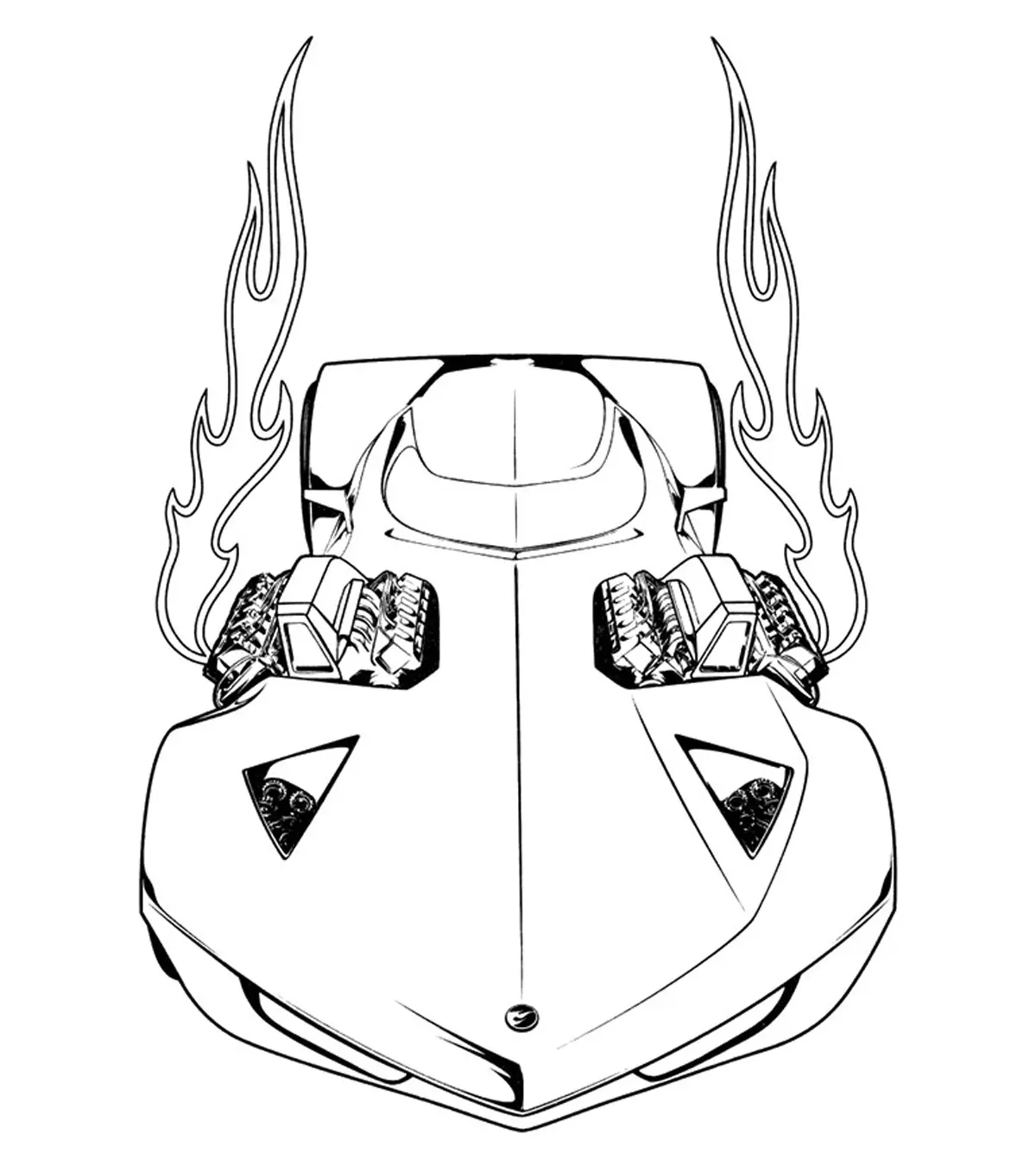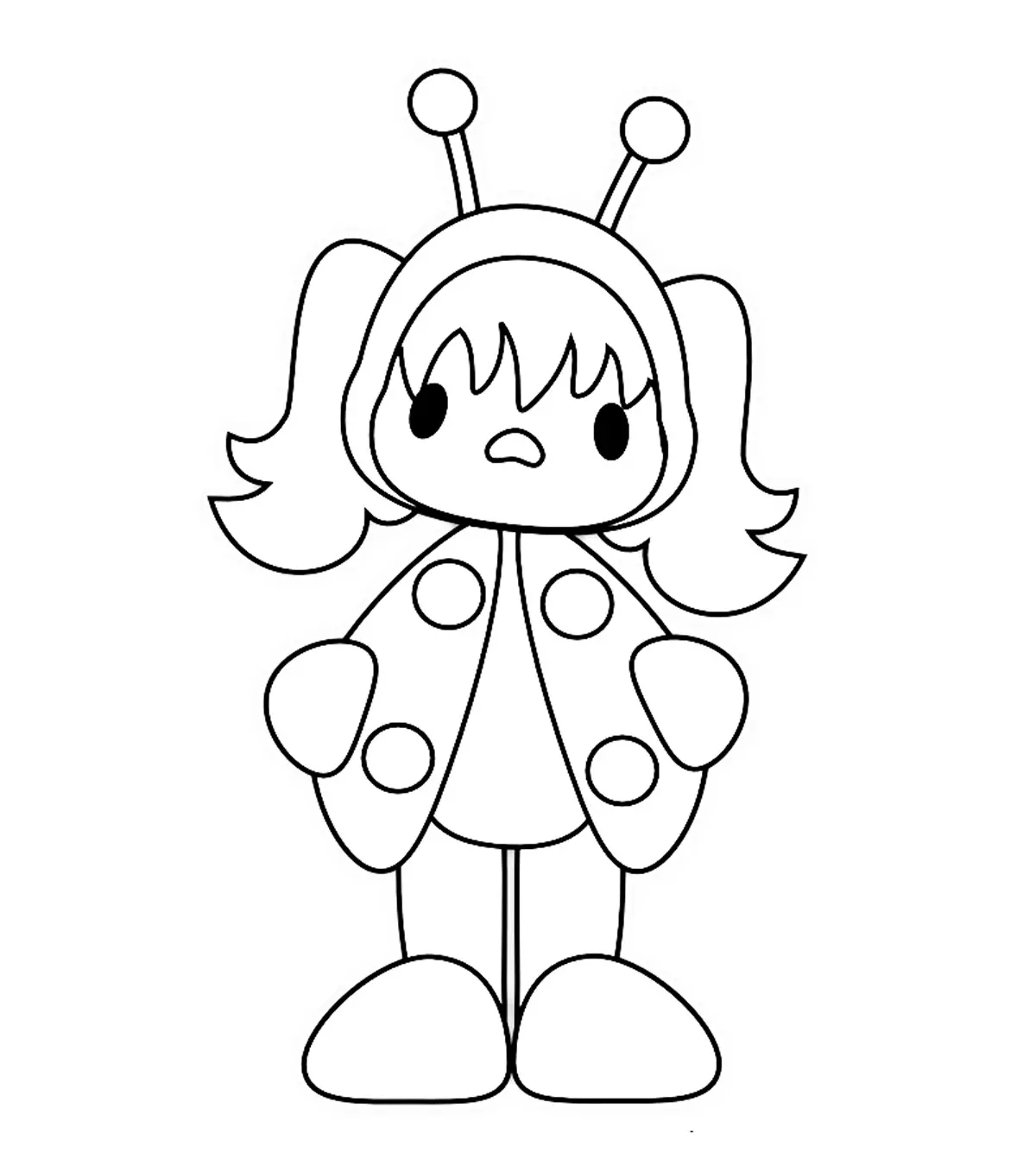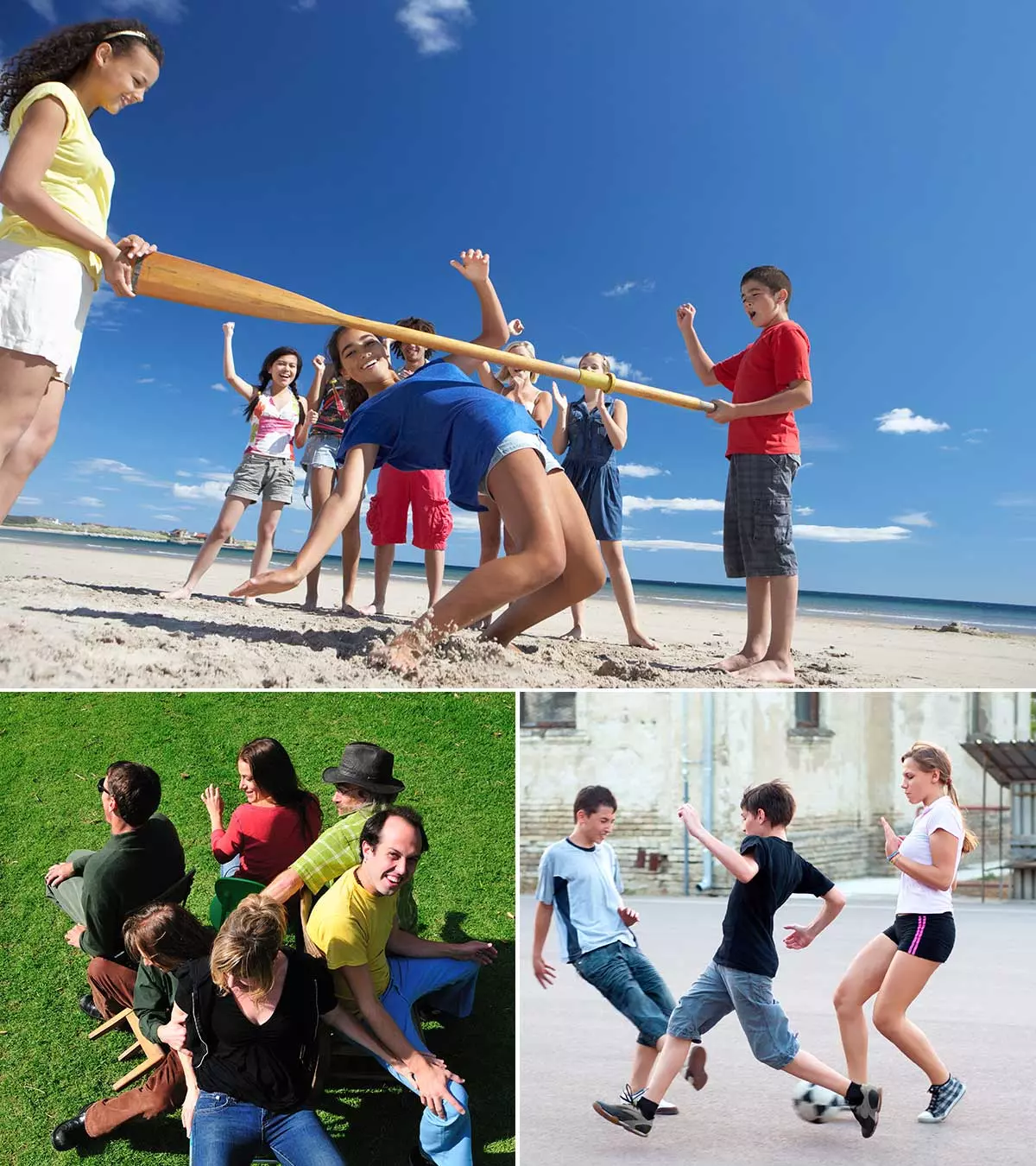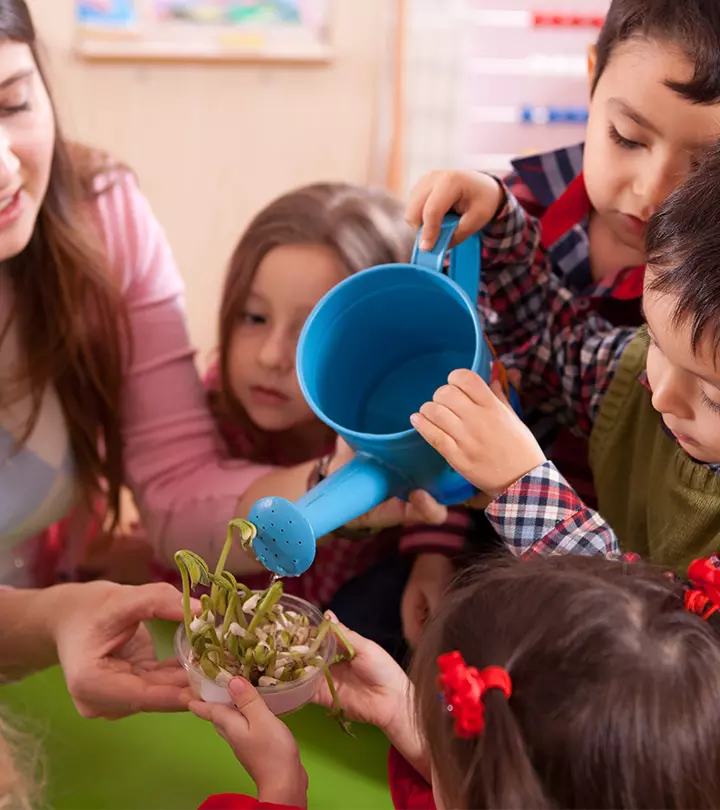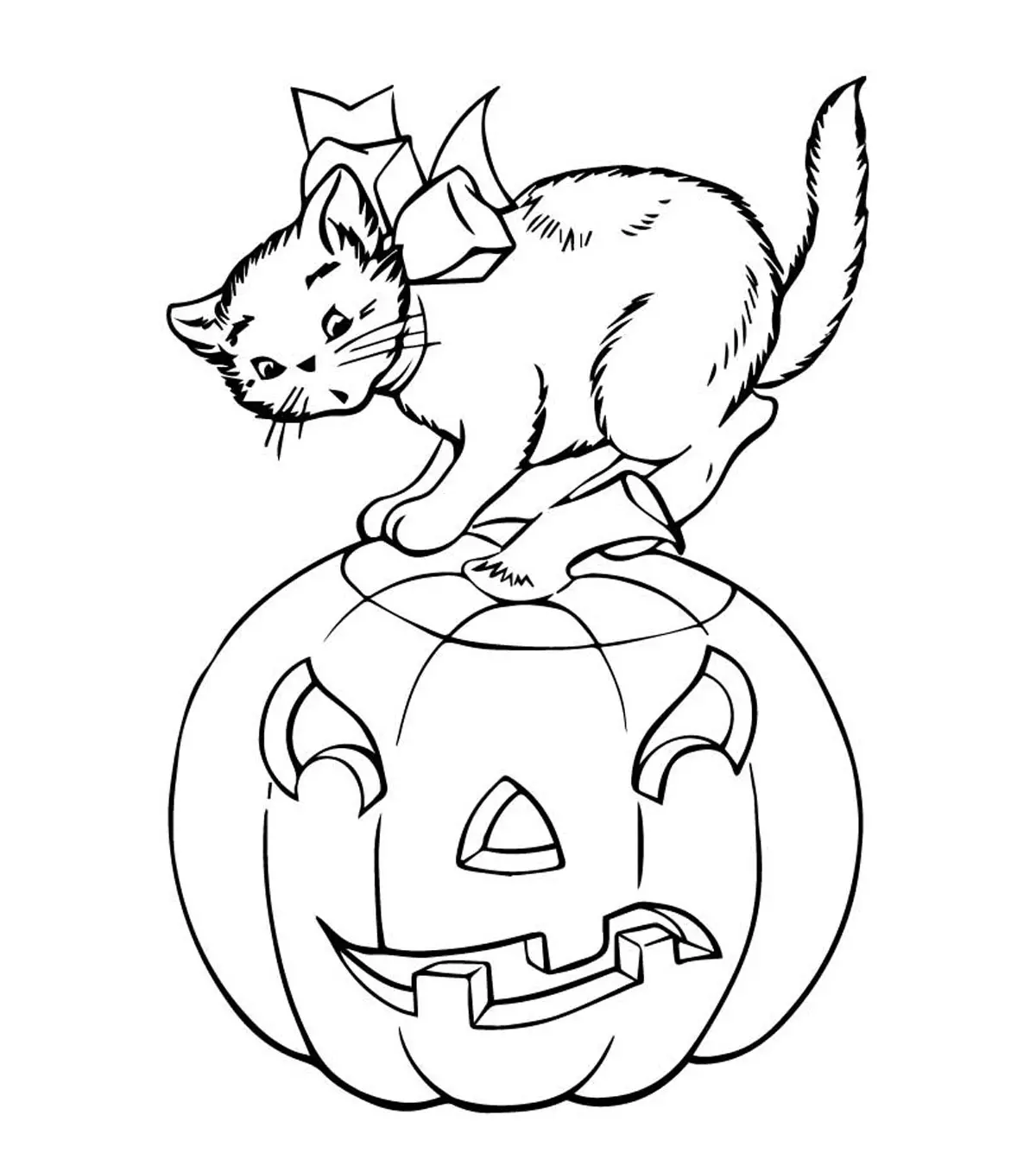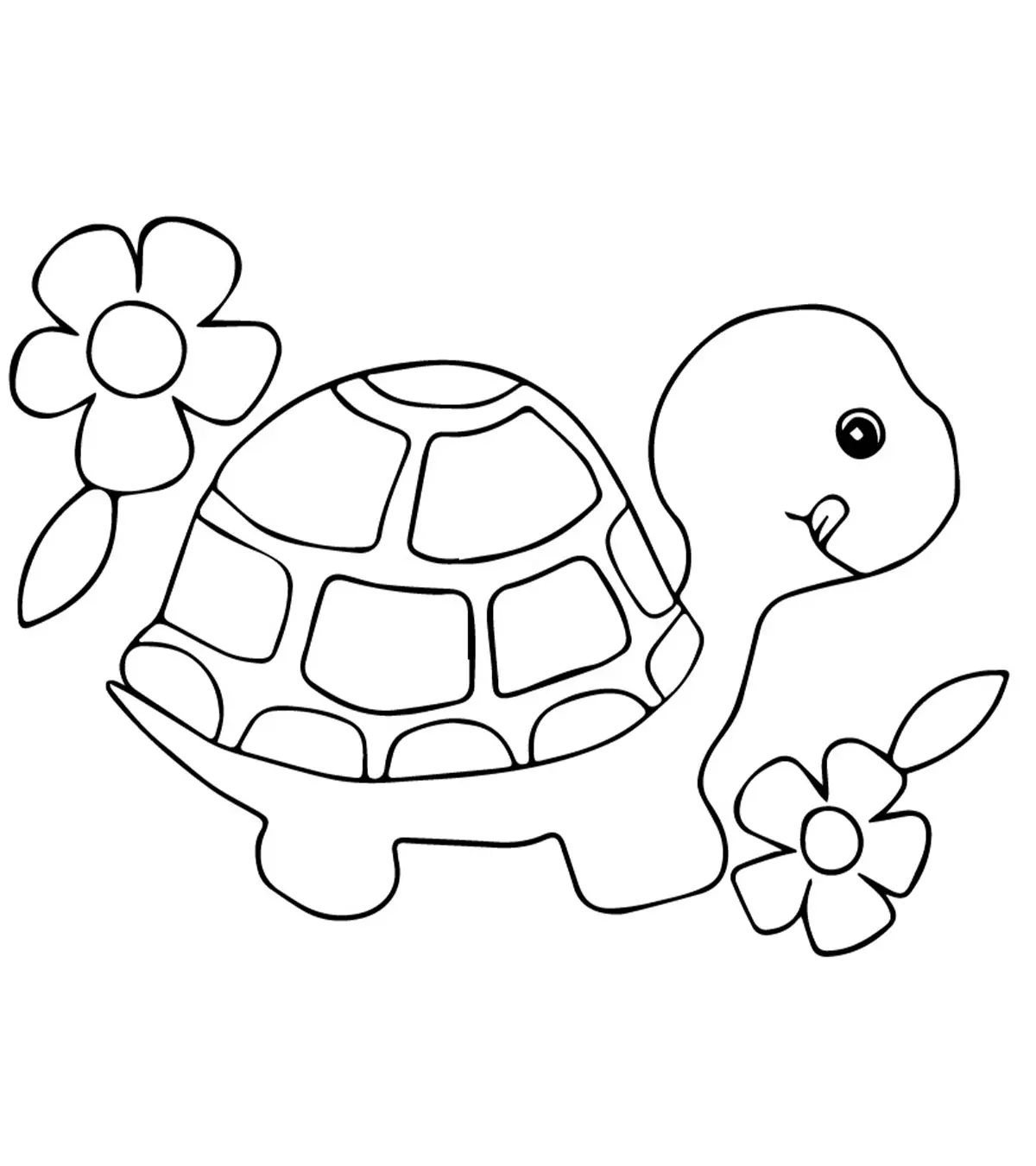
Image: Midjourney/ MomJunction Design Team
Music games for kids are a great way to teach them about the different genres of music. Music is certainly relaxing, and many consider it food for the soul. Exposing your child to different kinds of music and melodies, whether rock, classical, hip-hop, or pop, could inspire them to pick it up as a hobby and possibly a career too.

Watching musical performances may also help improve their listening skills. Music can positively impact children’s minds, as research suggests. In fact, musical education and training may enable a child’s brain to develop faster (1). It can also add more fun and frolic to the regular games they play every day.
This article features different engaging musical games for kids of all age groups to foster their musical skills, creativity, and collaborative abilities while ensuring a fun learning experience.
Key Pointers
- Exposing your child to different types of music can enhance their talent and creativity.
- Musical games like Musical Hide and Seek, The Passing Game, Musical Chair Reading, and Spin the Microphone are enjoyable group activities.
- Games such as What’s that Sound, Musical Trivia, and Make your Music can foster curiosity and learning in children.
- Musical games like Musical Masterpiece, karaoke competitions, Dance with Props, and Mood Music can engage children and improve their coordination.
Easy Music Games For Children

The idea of fun with music usually involves dancing. But is that the only choice? Well, no. Keep reading to find out.
1. Make your own music
Make your own music is a fun hand-clapping game for kids with a twist. It requires children to clap their hands or stomp their feet in rhythm, creating simple musical patterns or beats. This cool idea can be implemented in music classes to encourage a child’s interest in music in a fun and entertaining way.
You will need:
- Sheets of paper
- Color pens
How to play:
- Create symbols and denote the sounds they mean. For example, a star symbol means ‘clap’, a circle means ‘stomp your foot’, a triangle means ‘hit the desk’, and a square means ‘snap your fingers’.
- Put these instructions on the board and get the children to compose their own music, using only the symbols.
- Then let the children display their music on the board while the others follow the ‘notes’ to create the music.
They will clap, they will snap, and clap again before stomping their feet and hitting the desks…! And all of this will be music to their ears! Besides, music composition also encourages creativity in children.
2. Musical masterpiece
This game brings the best of both worlds – art or drawing and music – to bring out whatever talent the child has. The game is played best in groups or classrooms.
You will need:
- A music player or a computer
- Sheets of paper
- Color pens and pencils for the students
How to play:
- Give each student a sheet of paper and color pencils.
- Instruct the students to start drawing when you play the music and stop drawing when the music stops.
- Leaving the paper and pens at the desk, move to another desk and continue drawing and coloring in that sheet until the music stops again.
- Ask them to do so until you tell them to stop.
- In the end, they go back to their desks and see the final product.
Note – You can also put these instructions on a chart, big enough for the children to see and play the game.
3. Yes/no game
This is a warm-up game that works with choir groups or just a group of music students at a school.
You will need:
- Space to play
How to play:
- The parent or teacher is the conductor who will say a few musical or rhythmic phrases to begin with and the children will have to repeat.
- Then replace the notes with ‘Yes’ or ‘No’. The children will have to say the opposite of what you say, in the same rhythmic fashion.
- For example, if you sing, “No, no, no, yes, no, yes, no, no”, then the kids will have to sing “yes, yes, yes, no, yes, no, yes, yes”.
You can use only one word or mix up the two words to make it confusing and fun for the kids.
4. Musical Dress-up
This energetic game puts a playful spin on the classic musical chairs by adding a fashion twist.
You will need:
- A bag overflowing with wacky clothes and accessories (mismatched socks, oversized hats, superhero capes, etc.)
- Chairs arranged in a circle
- Music player
How to play:
- Set up the chairs in a circle for the children to sit.
- Pass around the bag filled with clothes and props once the music starts.
- When the music stops, the child holding the bag must pick out one item and put it on.
- Repeat until the bag is empty.
- The little fashionista with the most outrageous outfit wins.
You can feel free to add silly dance moves or silly walks as the children pass the bag for an extra dose of fun.
5. Musical hide and seek

This musical hide and seek is played with objects and is an excellent tool to help the child improve his listening skills.
You will need:
- A musical toy or device
- Hiding places
How to play:
- The objective of the game is for the child to find the toy by listening to its music.
- Turn the toy’s music on and hide it somewhere the child can find.
- Keep hiding the toy and make it a little complicated each time.
The more the child plays it, the better his listening skills get.
 Be watchful
Be watchful6. Rhyme and Move
Nursery rhymes are a delightful way to introduce young children to the world of language and music. Their simple rhythm and catchy tunes make them perfect for early childhood learning.
You will need:
- A collection of simple nursery rhymes
How to play:
- Introduce the child to the nursery rhymes, focusing on the rhythm.
- Once they are familiar with the words, incorporate actions that match the words.
- If actions seem overwhelming, clapping is a rather easy alternative. Clapping along the rhythm helps build confidence and coordination skills.
This engaging activity offers multiple benefits to young children, including improved language skills, musical development, and memory boost.
7. The passing game
The passing game is a popular party activity that can engage kids for a long time.
You will need:
- A gift or a package
- Wrapping paper
- Chocolates or small toys
How to play:
- Wrap the package with as many layers as possible. The more the layers, the better it is for the game.
- Between each layer, place a toffee or a small toy.
- Make the children sit in a circle. When the music starts, they pass the parcel. And when it stops, they stop.
- The kid who is holding the parcel when the music stops should unwrap one layer of the parcel to see if he gets a gift.
- The child moves out, and the rest of them continue the game.
The game is played until all the layers are unwrapped. Or you can have multiple parcels and play until there is just one person left.
8. Musical chair reading
This is a variation of the regular musical chairs party game and can be played in a class to encourage reading or recitation.
You will need:
- Chairs
- Space
- Music
How to:
- Pick an activity that you want each kid to take turns and do. You could try reading from a book or solving a math problem on the blackboard.
- Arrange the chairs in a circular fashion and play the music.
- The kids should walk as long as the music is playing and sit in the closest chair as soon as the music stops.
- The kid who is left standing when the music stops has to read a para from the book or solve the math problem on the board.
This can be a fun and impartial way to pick students for activities.
9. What’s that sound?
How does the guitar sound? What is the sound of the cello? If you want your child to identify and learn how different instruments sound, you should try this game.
You will need:
- Music player
- Different instrumental music
How to play:
- Play the sounds of different instruments first.
- Then play a simple song with distinct sounds of the instruments and ask the children to identify the instruments.
You can make each level more complicated by playing songs with not-so-distinct instrument sounds.
10. Musical trivia
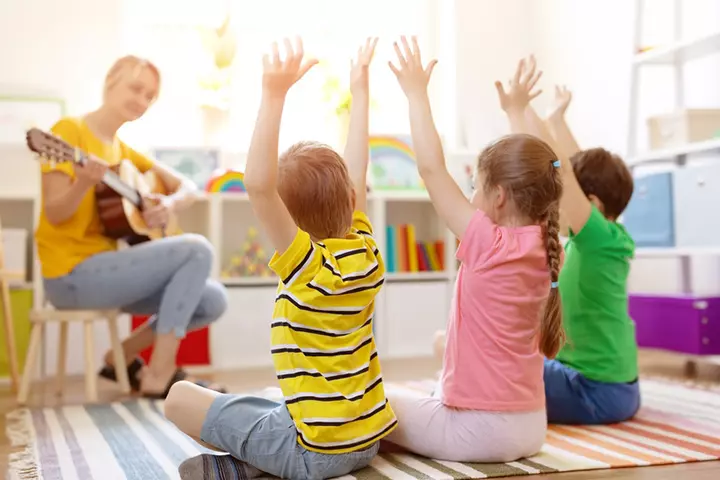
A quiz about music? Why not! If you want an activity for a music class, have trivia questions relating to musical notes or tunes. Otherwise, it could just be about your kid’s favorite bands or singers and their songs!
You will need:
- Set of questions
- Gifts
How to play:
- You could make this an individual event or a team event.
- When playing this at parties or school, divide the kids into groups. Give them cool team names – you could use names of composers.
- You could also use this for revising music lessons and give away gifts to kids who get the answers right.
11. Spin the microphone
Like spin the bottle, spin the mic is a chance game that can be customized any way you want. You can play truth or dare, or turn it into a trivia game or a karaoke event.
You will need:
- A functional microphone, preferably wireless
- List of activities or dares you to want the kids to do
How to play:
- Have the kids sit in a circle and place the mic in the center.
- Get one child to spin the mic.
- When it stops spinning, whoever the mic points to should do the dare or activity.
You could make this an elimination game where the person gets to move out of the circle after the activity and new people can join in to replace them.
 Point to consider
Point to consider12. Antakshari
A popular local game played in India and the Middle East, Antakshari is a parlor game played in teams. It usually involves singing movie soundtracks or regional movie songs. However, you can add some twist to this classic game and allow them to sing any kid-friendly songs they like.
You will need:
- Place to play
- Microphone (optional)
How to play:
- Establishing clear rules is essential to play the game without any glitches.
- To start the game, the moderator will pick a letter of the alphabet. The first team has to sing a song (no more than a para or two) starting with that letter.
- The next team has to sing a song starting with the consonant that the first team’s song ends with.
- And so on, each team has to sing a song starting with the consonant that the previous team’s song ends with.
- Any team that fails to do so will lose points.
The team with the highest number of points wins. You can make variations of this game to make it interesting. For instance, you can have different rounds or levels in the game where the kids have to sing songs only from a particular genre or a particular generation or by a particular type of band.
13. Karaoke competitions
Simple but pure fun, karaoke is one thing you can enjoy with family as well as friends.
You will need:
- A microphone and sound system
- Karaoke songs – make sure you pick songs that your child knows and enjoys singing
How to play:
- Write down a list of songs on small pieces of paper and put them in a box.
- Divide the participants into teams.
- Your child, along with the partner, has to sing-along the song correctly.
You could score them on tune and tone but avoid judging their singing voice. To make the competition challenging, throw in a few songs that they are not familiar with. That way, they’ll have to use whatever music knowledge they have to try and guess the right tune!
Now, how about we club singing games and dancing to make it more fun for the kids?
14. Move And Match

The dynamic game makes learning an exciting musical adventure. It’s an excellent approach to blend music and literacy abilities, making it ideal for young children.
You will need:
- Flashcards featuring letters of the alphabet
- Music player
How to play:
- Scatter the flashcards with letters around the room.
- Play an alphabet song or rhyme and invite children to dance or move around.
- When the music stops, announce a letter, prompting children to locate the flashcard.
This engaging game can spark the preschoolers’ love for learning and leave them singing their ABCs in no time.
15. Melody Match
The interesting game tests your child’s musical knowledge and memory interactively.
You will need:
Recordings of different songs
How to play:
- Play brief excerpts of different songs or musical pieces.
- Encourage children to guess the song or the artist.
- Award points for correct answers.
- The player with the highest score at the end of the game will be the winner.
Melody Match is a fantastic way to ignite your child’s love for music, test their knowledge, and create lasting memories filled with laughter and songs.
16. Nature Sound Quest
The outdoor activity can turn your backyard or park into a blend of sounds, helping children practice listening skills and enjoy nature.
You will need:
- Checklist of different sounds (e.g. bird’s song, running water, or dog barking)
- Outdoor space
How to play:
- Provide each child with a checklist of sounds to listen to.
- Lead a nature walk and prompt them to identify and mark the sounds they hear.
- Conclude the hunt by discussing various sounds encountered and their spots.
- The child who hears the maximum number of sounds from the checklist wins.
This engaging game helps children identify specific sounds and hone their listening skills and ability to distinguish different auditory cues.
17. Balloon Pop
Get ready for bouncing balloons with this energetic game that combines music, movement, and the hilarious challenge of keeping balloons afloat.
You will need:
- Inflated balloons
- Music player
How to play:
- Spread balloons across the play area.
- Play cheerful music and encourage children to dance and move freely.
- Children should try to hold the balloons with their hands, feet, or other body parts.
- If a balloon hits the ground, the child who touched it last gets eliminated from the game.
- The game continues until only one participant remains standing or the established time limit is met.
This game helps children develop valuable skills such as gross motor skills and strategic thinking.
18. Musical Instrumental Train

The game provides a fun and engaging way for children to explore the world of music while enhancing their cognitive and social development.
You will need:
- Noisemakers or homemade instruments (pots and spoons)
How to play:
- Make the children sit in a circle.
- Select one child to be the leader and make them stand in the center.
- The leader initiates the game by playing their instrument and producing a sound.
- The child next to the leader joins in, adding a different sound with their instrument.
- This sequence continues around the circle as each child contributes a unique sound, forming a musical train of diverse tones.
- Once all participants have joined in, the leader can introduce a new rhythm or melody for the “train” to follow.
Children can experiment with different sounds and rhythms to develop their auditory perception and musical expression.
19. Scavenger Hunt
Children can take part in a thrilling quest to uncover hidden objects scattered throughout the house or play area, transforming the typical scavenger hunt into an immersive auditory experience.
You will need:
- A list of hidden objects with corresponding sounds (e.g., a bell, a crinkling bag, a ticking clock)
How to play:
- Hide different items all across the house or a specific play space. Give children the list with hints about where the hidden items are and the sounds they make.
- Play upbeat music to create excitement and prompt them to start looking around while singing.
- The first player to find all the items listed wins the game.
The interactive game not only sharpens their listening skills but also fosters the ability to associate sounds with corresponding objects.
20. Guess the Instrument
Guess the instrument is an engaging game that stimulates children’s creativity and musical expression.
You will need:
- Music player
- Timer
How to play:
- Designate one child as the imitator.
- The imitator stands in front and simulates playing different instruments through facial expressions, body language, and hand gestures.
- The remaining children try to guess the instrument with the help of the imitator’s imitations.
- The child who guesses the maximum number of instruments wins.
The game encourages imagination and a deeper appreciation for the art of music.
Games That Make You Move To The Music
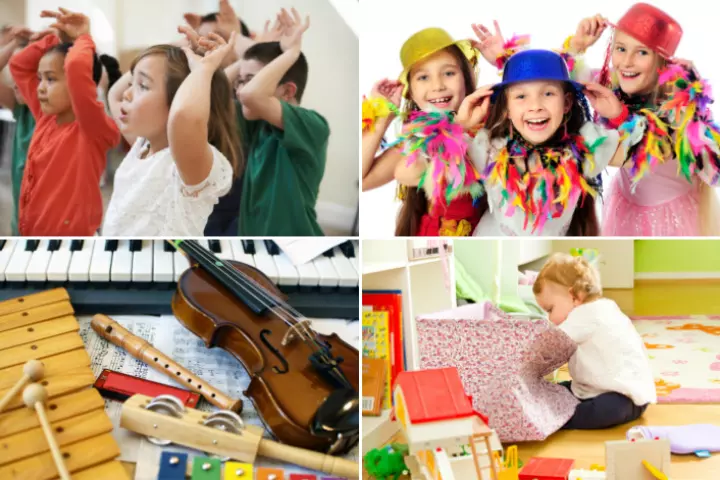
Want to get your child moving and grooving to some beats? Try out these interactive games that combine physical activity with musical enjoyment.
21. Dance with props
A simple and silly music game for all ages, dance with props allows you to get creative too.
You will need:
- Music player
- Props such as hats, balloons, ribbons, pom-poms, wigs, teddy bears, flowers, and so on
- Space to dance
How to play:
- Create a dance floor – remove any obstacles and make the place child-friendly.
- Place all the props on a table, to the side of the room.
- As soon as you play the music, the kids will have to run to the table and pick a prop. You can also ask them to pick any other accessory from the room (as long as it is safe) to dance.
- Then dance any way they want while using the prop as an accessory.
- Once the music ends, they put the prop back on the table.
- They go back and pick another prop when the music begins again, and continue dancing in that style.
This way, they can dance for as long as they want!
22. Tissue dance
A tissue dance is more like a balancing act and less of a dance form. But, it is fun!
You will need:
- A box of tissues
- Space to dance
- Music player
How to play:
- Give each child a tissue and ask them to put it on their head.
- When the music starts, they should start dancing and moving on the dance floor, without letting the tissue fall.
- If the tissue falls off the child’s head and he or she catches it before it touches the ground, they can put it back on their head and continue dancing.
- But if the tissue falls on the ground, the kid is out.
- The last one to stand dancing with the tissue is the winner.
23. Musical statues
A game for one or more people, musical statues can be enjoyed by kids of all ages.
You will need:
- Music player
- Space to dance
How to play:
- Play the music and ask the kids to dance.
- When the music stops, the children should freeze like statues.
- The kids have to stand like that for a minute or so, and anyone who moves, giggles, or even wobbles when the music is not playing is out.
- When the music is back on, they continue dancing.
The last person dancing on at the end is the champion statue!
Mrs Martin, a blogger and an elementary school music teacher, explains how she taught music lessons to students in third and fifth grades. She says, “I developed this statue game within the constraints of mask-wearing, singing not allowed in person, no shared materials, and social distancing. For this game, I used the song “I Lost the Farmer’s Dairy Key” from 150 American Folk Songs edited by Peter Erdei. I made the connection between the song and the game by saying that the students are statues in the “lady’s garden” from the song. I made it exciting by telling them it was a magic garden where one of the statues would change positions when the farmer wasn’t looking. I use this song to teach anacrusis/pickup. They need LOTS of repetitions of the song to internalize the beat structure. So…we turn it into a game (i)!”
24. Mood music
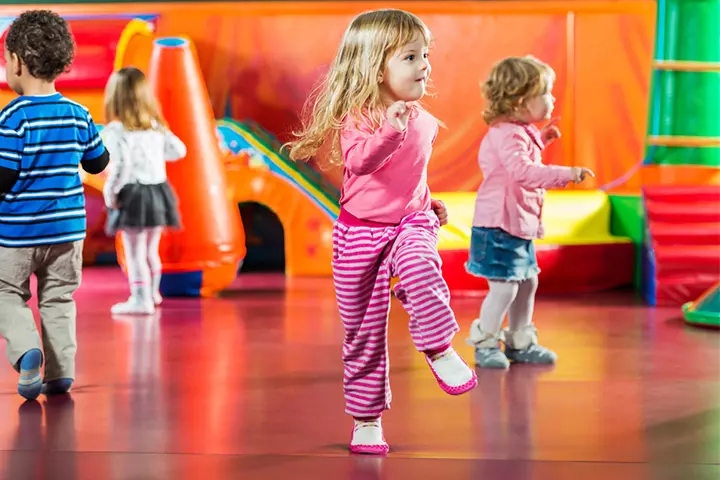
This is an excellent way to introduce the kids to different genres of music and the many emotions linked to them. This will help children connect actions with emotions.
You will need:
- A collection of songs depicting different emotions – anger, happiness, sadness, and silliness
- Music player and preferably a musical app like Spotify or YouTube.
- Space to dance
How to play:
- Make sure you pick songs that are appropriate for the child’s age.
- Then explain the game to the kids and ask them how they would behave when they are happy, sad, cross, etc.
- Then tell them that they have to dance according to the mood of the song, which you will mention before playing it.
- So for a happy song, you want the kids jumping and moving energetically, while for a sad song they might simply sway.
- They could dance silly or aggressively (not violently) when they are angry.
In short, whatever is the mood of the song, the kids have to act it when they dance.
25. Dance like an animal
That’s right. This game will make the kids dance like an animal, literally! Read on to know how.
You will need:
- A chart of animals/birds/reptiles
- Songs of different genres
- Space to dance
- Music player
How to play:
- Put the chart of animals at a place where all the kids can see it.
- If the kids are too young, you might want to explain the traits of each animal on the chart before you start the game. You need to tell them how the animal moves, how fast or slow it moves, the sounds it makes, and any other unique traits it has.
- For example, a kid who picks a dog has to be on all fours and bark in between while dancing or swaying. A snake has to crawl on the floor and a bird will flap its wings when dancing.
- If need be, you could show them a few moves and get a few giggles in return.
- Play the music, keep shuffling between genres, from slow to fast and vice versa.
Watch the fun!
26. Party island
The game is highly popular at teen parties and is usually for couples. But, it can be modified a bit to suit children of all ages.
You will need:
- Music player
- Space (a lot of it) for dancing
- Newspapers
How to play:
- This is a challenging game in which the child has to use his spatial intelligence and his ability to balance to win.
- Give each child a sheet of the newspaper and enough space between to dance comfortably.
- When the music starts, the children will put the paper on the floor and dance on it. They cannot step on the floor while the music is on.
- After a few minutes, stop the music and ask the children to fold the paper exactly in half and put it back on the floor.
- When the music starts, the kids have to dance on the folded paper and not step on the folder.
After every few minutes, the kids have to fold the paper in half and dance on it. The smaller the paper gets, the difficult it would be for the kids to stay on it. The child who manages to dance only on the last folded piece of paper wins!
27. Strictly come dancing
This is a group dance competition for kids of all ages. All you need to do is give them some props and accessories, ask them to pick a song of their choice, and prepare a dance routine.
You will need:
- Music player
- Space to dance
- Props and costumes if any for the dancers
How to play:
- Divide the kids into teams or groups. Give them props or accessories.
- Let them pick a song of their choice and prepare a dance routine using the accessories.
- Have a competition between the groups, and the team that performs best wins.
28. Musical limbo
Limbo is a game that tests how flexible the body is. Add music, and it becomes all the more fun. In musical limbo, you don’t just walk under the beam. You have to go dancing from under it!
You will need:
- A long stick or beam
- Music player
- Space to play
How to play:
- Have two adults hold the beam at a height such that the kids can pass from under it without a lot of effort.
- There are two simple rules to this game: the kids have to dance to move, and they should not touch the beam.
- Play the music and have the children move from under the beam, one after the other.
- Whoever touches the pole or fails to dance while under it is out of the game.
- After one round, lower the beam a little and repeat the routine.
- Do it until there is only one kid left. The kid who manages to last till the end wins!
29. Draw what you hear
As the game’s name suggests, this activity encourages children to use their imagination and have fun while honing their drawing skills.
You will need:
- Speakers or a phone to play music.
- A selection of music (from your collection, YouTube, or a Spotify playlist).
- Paper, pencil, and coloring material (paper plates, paint, or chalk for outdoor activities).
- Chairs and tables.
How to play:
- Set up a music-playing device and arrange drawing materials.
- Let the children sit in a comfortable, upright position with their eyes closed.
- Play a section of a song, hiding its title to avoid influencing the drawing.
- Ask them to think about how the music makes them feel and the images that come to their mind.
- Have them draw something inspired by their imaginations.
30. Dance Showdown
The vibrant activity goes beyond dancing – it’s about appreciating the creativity and teamwork behind creating a captivating dance routine.
You will need:
A music player
Plenty of space
Optional: Props or costumes to enhance the experience
How to play:
- Divide the children into two or more teams and provide them with props if desired.
- Allow each team to select their music and choreograph a dance routine.
- After every team has performed, declare the best team as the winner.
The game encourages children to value the effort involved in figuring out the moves, creating routines, and practicing. It also promotes teamwork and enhances communication skills.
31. Follow The Leader
In this game, children mimic the movements of a leader to music. It is known for promoting coordination, observation skills, and creativity.
You will need:
- Music player
How to play:
- Choose a leader to start the game.
- Play music and make the leader perform different movements.
- The other children mimic the leader’s movements.
- Rotate the leader role periodically.
It is a fun musical activity that makes children come out of their comfort zone and get along with each other.
32. Hopscotch Dance
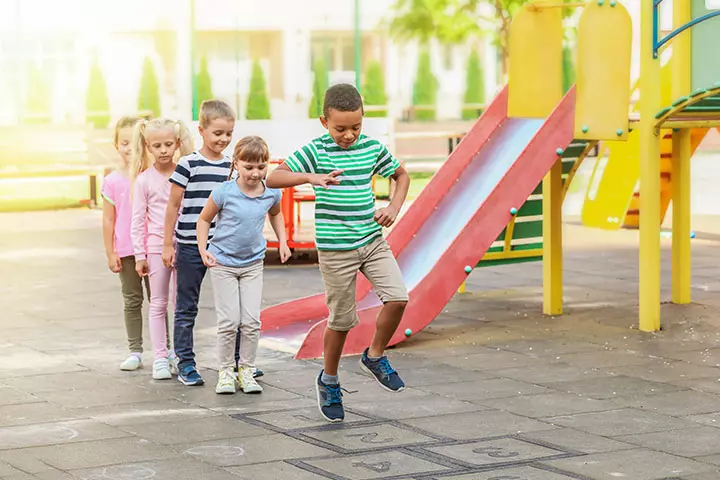
The combination of hopscotch and dance is a fun game for children as they dance while balancing their way through the grid.
You will need:
- Music player
- Chalk (for outdoor play) or tape (for indoor play)
How to play:
- Create a hopscotch grid on the floor.
- Play music and make children dance through the grid, hopping from one square to another.
- You may add different dance moves for each square.
33. Musical Charades
It is a lively game that combines the fun of charades with a musical twist. It’s a great way to engage children in a guessing game while allowing them to express themselves through dance and movement.
You will need:
- Paper
- Pen
How to play:
- Divide the children into two teams.
- Write different songs on slips of paper.
- One team picks a slip and performs the hook step of that song while the other team has to guess.
The team with the maximum number of correct answers wins.
34. Mirror Moves
Mirror Moves is an energetic and fun-filled game where children mimic each other’s dance moves.
You will need:
- Music player
How to play:
- Divide the children into two groups. One group will be the ‘leaders’ and the other will be the ‘mirrors.’
- Make the leaders stand facing the mirrors.
- Play some upbeat music.
- The leaders start dancing with creative and varied movements.
- The mirrors must copy the leaders’ moves exactly as if they are reflections.
After a few minutes, switch roles so everyone gets a chance to be both a leader and a mirror.
35. Dance Relay
Dance Relay is a lively and interactive game where children combine the excitement of a relay race with the fun of dancing.
You will need:
- Music player
How to play:
- Divide children into teams.
- Set a course and play music.
- The first child dances to a point and back, tagging the next teammate.
- Continue until all team members have danced.
36. Dance Corners
It is an exciting game where children dance to music and move to different corners when the music stops. It promotes quick thinking and physical activity.
You will need:
- Music player
- Four different colored markers or signs for the corners
How to play:
- Place the colored markers or signs in every corner of the play area.
- Play music and let the children dance.
- When the music stops, call out a color, and children must run to the corresponding corner.
- The last child to reach the corner is eliminated.
37. Musical Shapes
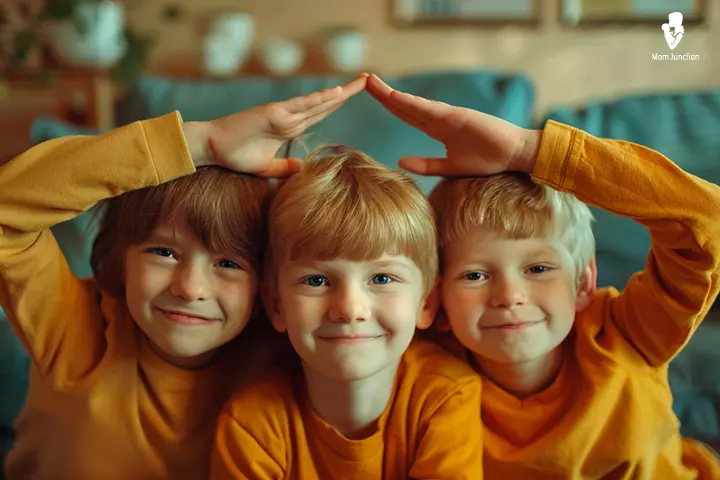
This is a dynamic game where children dance and form different shapes with their bodies when the music stops. It also helps children understand geometric shapes and spatial relationships.
You will need:
- Music player
- List of shapes (e.g. Circle, square, triangle)
How to play:
- Play music and let the children dance freely.
- Stop the music and call out a shape.
- Children must quickly form the shape with their bodies, either alone or with others.
- Continue with different shapes and music.
38. Musical Hula Hoops
Musical Hula Hoops is an energetic game where children dance to music and hop into hula hoops when the music stops, similar to musical chairs but with a twist.
You will need:
- Music player
- Hula hoops
How to play:
- Place hula hoops in a circle on the ground.
- Play music and let the children dance around the hula hoops.
- When the music stops, children must find a hula hoop to stand in.
- Remove one hula hoop after each round.
- The child left without a hula hoop is out, and the game continues until only one child remains.
39. Simon Says
It is a lively game where children follow musical instructions, combining the classic Simon Says with music.
You will need:
- Music player
How to play:
- Play music and act as ‘Simon,’ giving instructions like ‘Simon says clap your hands to the beat.’
- Children must follow the instructions only if they start with ‘Simon says.’
- If an instruction is given without ‘Simon says,’ they should remain still.
- Those who follow incorrect instructions can be out of the game.
40. Obstacle Course
The game combines music with an obstacle course, challenging children to navigate through various physical activities to the beat.
You will need:
- Music player
- Items for the obstacle course (cones, hoops, tunnels)
How to play:
- Set up an obstacle course with different challenges (e.g., crawling through a tunnel, jumping over cones).
- Play music and make the children navigate the course in time with the beat.
- Encourage different movements (e.g., hopping, skipping) to match the music.
- The child who finishes the course into the best way and in the least amount of time wins.
Frequently Asked Questions
1. What age group is suitable for music games for children?
A musical or sound-producing toy is one of the first toys given to infants. So, playing music games is not fully restricted by age. If a child knows how to identify and differentiate between sounds, they are suitable to play music games.
2. Can music games for children be played on mobile devices?
Yes, both android and iPhone have music game options in their respective app stores.
3. Can music games improve a child’s creativity and imagination?
Yes, music games can positively impact a child’s creativity and imagination. By engaging in activities such as singing, playing instruments, and composing music, children are encouraged to think creatively, express themselves artistically, and explore their imagination through the world of music (2).
4. What are the key features to consider when choosing music games for kids?
When deciding on music games for children, ensure the games are suitable for the child’s age, offer interactive and captivating gameplay, incorporate educational elements, and provide a diverse range of musical activities.
5. How can music games encourage social interaction among children?
Music games can promote social interaction among children by creating opportunities for collaboration and teamwork. Engaging in group music-making activities encourages communication, coordination, and cooperation. Children learn to listen to and appreciate each other’s contributions, take turns, and work together.
6. How can parents actively participate in music games with their children?
Parents can engage in music games with their children by playing instruments together, singing along with them, and participating in rhythmic movements or dancing. They can offer encouragement, initiate conversations about the music, and create an atmosphere of shared enjoyment.
Music adds a spark to life and has therapeutic effects that heal the body and mind. From making your music to antakshari and karaoke, these musical games for kids are a great way to let your child hop, twist, and shake to the music and enjoy. You can select a suitable musical game based on your child’s age and interests. Use these games to introduce your little one to different genres of music and diversify their understanding. Club the music they love with usual games, such as hopscotch, or add music to daily chores to make them enjoyable. For those inclined, they can learn musical theory that can help them understand the rhythm and timings while playing the musical instruments. Children are able to retain musical memory and creativity through these games and it forms an important part of early childhood development. They can also learn through these play activities that offer a fun learning experience.
Infographic: Easy And Fun Music Games For Children
If your child loves and appreciates music, they’ll surely enjoy playing musical games. We bring you a list of some amazing games that can keep them hooked. They can be played in a play school setting or when your little one’s friends come over for a play date. Keep this infographic handy, so you can use it at the right time.
Some thing wrong with infographic shortcode. please verify shortcode syntax
Illustration: Amazing Music Games And Activities For Kids
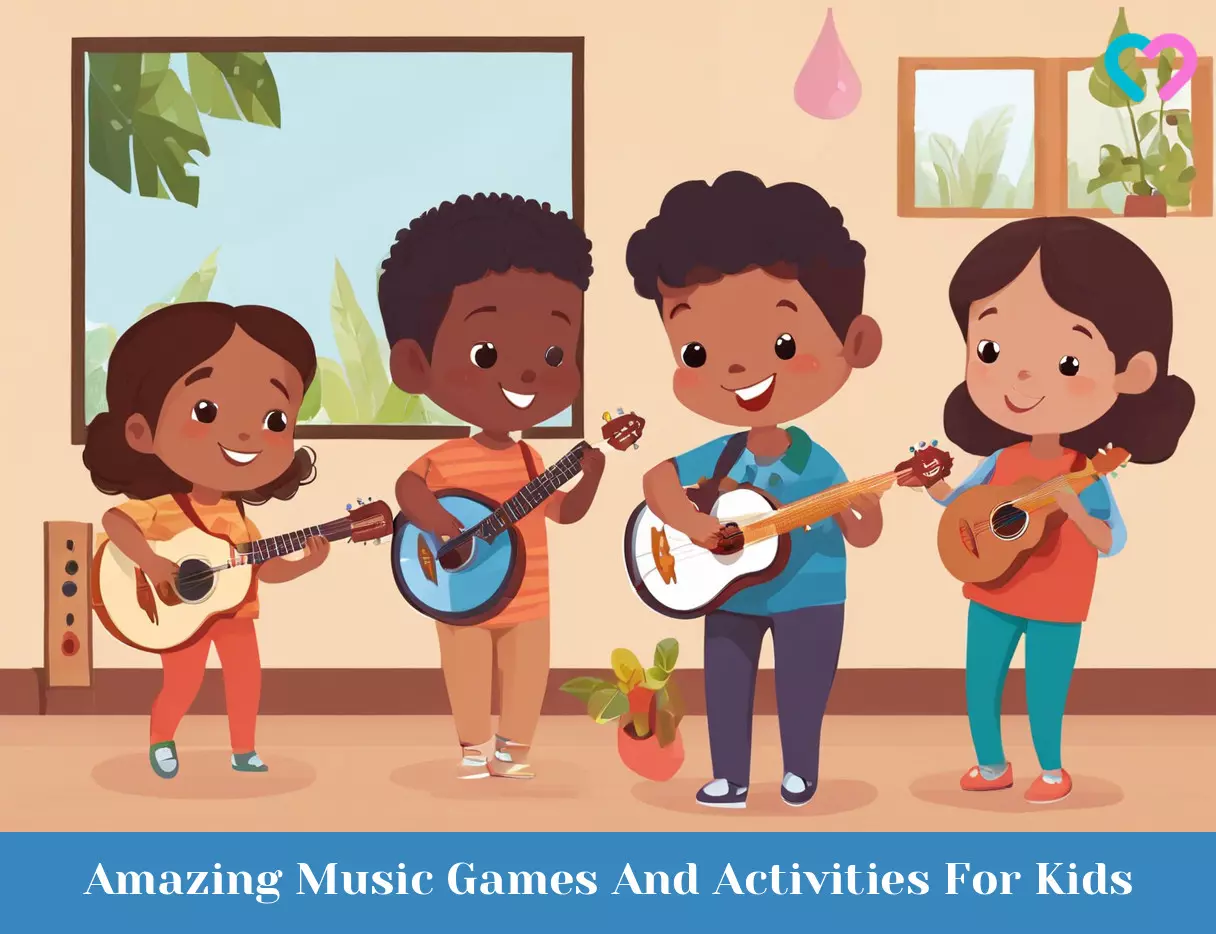
Image: Stable Diffusion/MomJunction Design Team
This musical card game is perfect for kids to practice their English skills. Enjoy the fun of flashcards with a musical twist!
Personal Experience: Source
MomJunction articles include first-hand experiences to provide you with better insights through real-life narratives. Here are the sources of personal accounts referenced in this article.
i. Statue-game For Virtual, In-person, Hybrid, or Social Distancing;https://mrsmartinsmusicroom.wordpress.com/category/ideas-2/
References
- Children’s brains develop faster with music training
https://today.usc.edu/102681/childrens-brains-develop-faster-with-music-training/ - Creative activities for preschooler learning and development.
https://raisingchildren.net.au/preschoolers/development/creative-development/preschooler-creative-activities
Community Experiences
Join the conversation and become a part of our nurturing community! Share your stories, experiences, and insights to connect with fellow parents.
Read full bio of Dr. Neha Mehta
Read full bio of Harshita Makvana
Read full bio of Deepa Thomas
Read full bio of Nisha Bharatan











